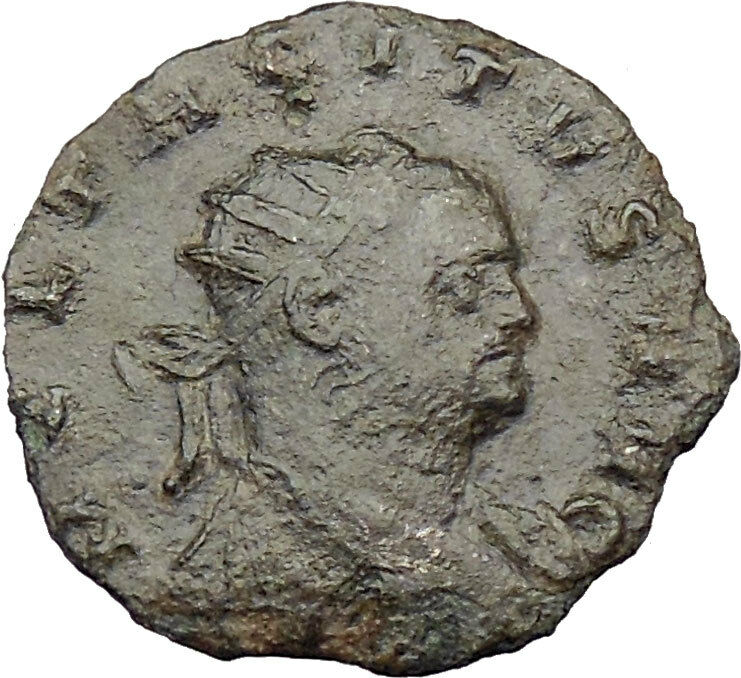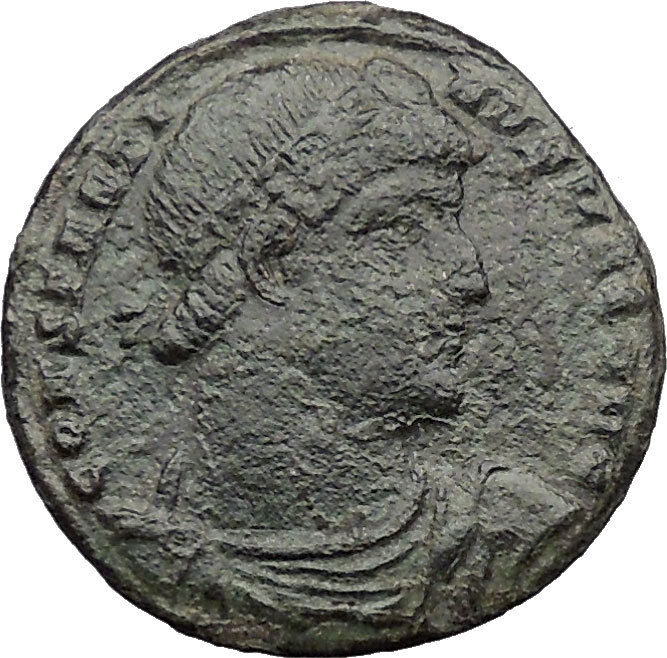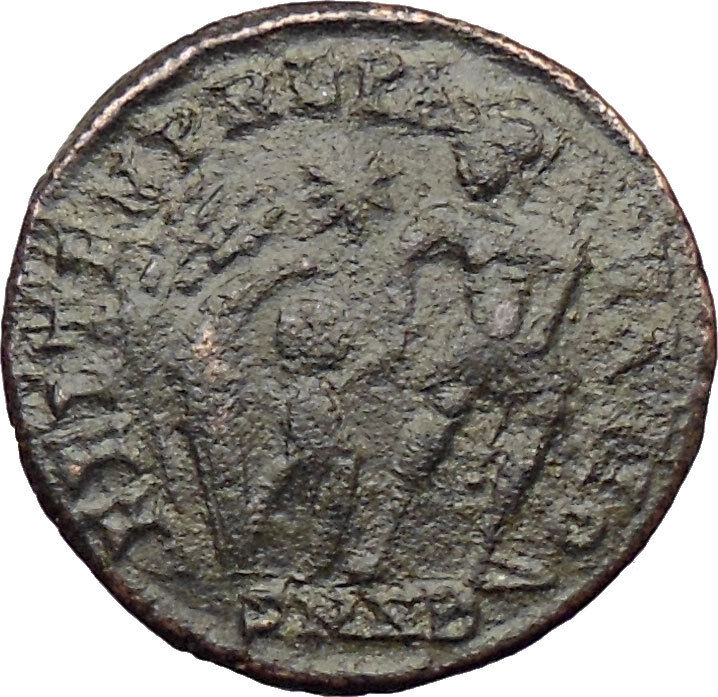|
Licinius I – Roman Emperor 308-324 A.D.
Billon Follis 22mm (4.18 grams) Rome mint, struck 313 A.D.
Reference: RIC VI Rome 349c; Sear 15307
IMP LICINIVS P F AVG, laureate cuirassed bust right.
SPQR OPTIMO PRINCIPI / RS, three standards surmounted by hand, eagle and wreath.
You are bidding on the exact item pictured, provided with a Certificate of Authenticity and Lifetime Guarantee of Authenticity.
Standards
.jpg/400px-035_Conrad_Cichorius,_Die_Reliefs_der_Traianssäule,_Tafel_XXXV_(Ausschnitt_01).jpg) Roman military standards. The standards with discs, or signa (first three on left) belong to centuriae of the legion (the image does not show the heads of the standards – whether spear-head or wreathed-palm). Note (second from right) the legion’s aquila. The standard on the extreme right probably portrays the She-wolf (lupa) which fed Romulus, the legendary founder of Rome. (This was the emblem of Legio VI Ferrata, a legion then based in Judaea, a detachment of which is known to have fought in Dacia). Detail from Trajan’s Column, Rome Roman military standards. The standards with discs, or signa (first three on left) belong to centuriae of the legion (the image does not show the heads of the standards – whether spear-head or wreathed-palm). Note (second from right) the legion’s aquila. The standard on the extreme right probably portrays the She-wolf (lupa) which fed Romulus, the legendary founder of Rome. (This was the emblem of Legio VI Ferrata, a legion then based in Judaea, a detachment of which is known to have fought in Dacia). Detail from Trajan’s Column, Rome  Modern reenactors parade with replicas of various legionary standards. From left to right: signum (spear-head type), with four discs; signum (wreathed-palm type), with six discs; imago of ruling emperor; legionary aquila; vexillum of commander (legatus) of Legio XXX Ulpia Victrix, with embroidered name and emblem (Capricorn) of legion Modern reenactors parade with replicas of various legionary standards. From left to right: signum (spear-head type), with four discs; signum (wreathed-palm type), with six discs; imago of ruling emperor; legionary aquila; vexillum of commander (legatus) of Legio XXX Ulpia Victrix, with embroidered name and emblem (Capricorn) of legion
Each tactical unit in the imperial army, from centuria upwards, had its own standard. This consisted of a pole with a variety of adornments that was borne by dedicated standard-bearers who normally held the rank of duplicarius. Military standards had the practical use of communicating to unit members where the main body of the unit was situated, so that they would not be separated, in the same way that modern tour-group guides use umbrellas or flags. But military standards were also invested with a mystical quality, representing the divine spirit (genius) of the unit and were revered as such (soldiers frequently prayed before their standards). The loss of a unit’s standard to the enemy was considered a terrible stain on the unit’s honour, which could only be fully expunged by its recovery.
The standard of a centuria was known as a signum, which was borne by the unit’s signifer. It consisted of a pole topped by either an open palm of a human hand or by a spear-head. The open palm, it has been suggested, originated as a symbol of the maniple (manipulus=”handful”), the smallest tactical unit in the Roman army of the mid-Republic. The poles were adorned with two to six silver discs (the significance of which is uncertain). In addition, the pole would be adorned by a variety of cross-pieces (including, at bottom, a crescent-moon symbol and a tassel). The standard would also normally sport a cross-bar with tassels.
The standard of a Praetorian cohort or an auxiliary cohort or ala was known as a vexillum or banner. This was a square flag, normally red in colour, hanging from a crossbar on the top of the pole. Stitched on the flag would be the name of the unit and/or an image of a god. An exemplar found in Egypt bears an image of the goddess Victory on a red background. The vexillum was borne by a vexillarius. A legionary detachment (vexillatio) would also have its own vexillum. Finally, a vexillum traditionally marked the commander’s position on the battlefield.[194] The exception to the red colour appears to have been the Praetorian Guard, whose vexilla, similar to their clothing, favoured a blue background.
From the time of Marius (consul 107 BC), the standard of all legions was the aquila (“eagle”). The pole was surmounted by a sculpted eagle of solid gold, or at least gold-plated silver, carrying thunderbolts in its claws (representing Jupiter, the highest Roman god. Otherwise the pole was unadorned. No exemplar of a legionary eagle has ever been found (doubtless because any found in later centuries were melted down for their gold content). The eagle was borne by the aquilifer, the legion’s most senior standard-bearer. So important were legionary eagles as symbols of Roman military prestige and power, that the imperial government would go to extraordinary lengths to recover those captured by the enemy. This would include launching full-scale invasions of the enemy’s territory, sometimes decades after the eagles had been lost e.g. the expedition in 28 BC by Marcus Licinius Crassus against Genucla (Isaccea, near modern Tulcea, Rom., in the Danube delta region), a fortress of the Getae, to recover standards lost 33 years earlier by Gaius Antonius, an earlier proconsul of Macedonia. Or the campaigns of AD 14-17 to recover the three eagles lost by Varus in AD 6 in the Teutoburg Forest.
Under Augustus, it became the practice for legions to carry portraits (imagines) of the ruling emperor and his immediate family members. An imago was usually a bronze bust carried on top of a pole like a standard by an imaginifer.
From around the time of Hadrian (r. 117-38), some auxiliary alae adopted the dragon-standard (draco) commonly carried by Sarmatian cavalry squadrons. This was a long cloth wind-sock attached to an ornate sculpture of an open dragon’s mouth. When the bearer (draconarius) was galloping, it would make a strong hissing-sound.
Decorations
The Roman army awarded a variety of individual decorations (dona) for valour to its legionaries. Hasta pura was a miniature spear; phalerae were large medal-like bronze or silver discs worn on the cuirass; armillae were bracelets worn on the wrist; and torques were worn round the neck, or on the cuirass. The highest awards were the coronae (“crowns”), of which the most prestigious was the corona civica, a crown made oak-leaves awarded for saving the life of a fellow Roman citizen in battle. The most valuable award was the corona muralis, a crown made of gold awarded to the first man to scale an enemy rampart. This was awarded rarely, as such a man hardly ever survived.
There is no evidence that auxiliary common soldiers received individual decorations like legionaries, although auxiliary officers did. Instead, the whole regiment was honoured by a title reflecting the type of award e.g. torquata (“awarded a torque”) or armillata (“awarded bracelets”). Some regiments would, in the course of time, accumulate a long list of titles and decorations e.g. cohors I Brittonum Ulpia torquata pia fidelis c.R..
Licinius I – Roman Emperor 308-324 A.D.
| Husband of Constantia | Father of Licinius II | Son-in-law of Theodora and (posthumously) Constantius I | Uncle of Delmatius, Hanniballianus, Constantius Gallus, Julian II and Nepotian | Half-brother-in-law of Constantine the Great |
Licinius I (Latin: Gaius Valerius Licinianus Licinius Augustus; c. 263-325) was a Roman emperor from 308 to 324. For most of his reign he was the colleague and rival of Constantine I, with whom he co-authored the Edict of Milan that granted official toleration to Christians in the Roman Empire. He was finally defeated at the Battle of Chrysopolis, before being executed on the orders of Constantine I.

Sculptural portraits of Licinius (left) and his rival Constantine I (right).
Born to a Dacian peasant family in Moesia Superior, Licinius accompanied his close childhood friend, the future emperor Galerius, on the Persian expedition in 298. He was trusted enough by Galerius that in 307 he was sent as an envoy to Maxentius in Italy to attempt to reach some agreement about the latter’s illegitimate political position. Galerius then trusted the eastern provinces to Licinius when he went to deal with Maxentius personally after the death of Flavius Valerius Severus.
Upon his return to the east Galerius elevated Licinius to the rank of Augustus in the West on November 11, 308. He received as his immediate command the provinces of Illyricum, Thrace and Pannonia. In 310 he took command of the war against the Sarmatians, inflicting a severe defeat on them and emerging victorious. On the death of Galerius in May 311, Licinius entered into an agreement with Maximinus II (Daia) to share the eastern provinces between them. By this point, not only was Licinius the official Augustus of the west but he also possessed part of the eastern provinces as well, as the Hellespont and the Bosporus became the dividing line, with Licinius taking the European provinces and Maximinus taking the Asian.
An alliance between Maximinus and Maxentius forced the two remaining emperors to enter into a formal agreement with each other. So in March 313 Licinius married Flavia Julia Constantia, half-sister of Constantine I, at Mediolanum (now Milan); they had a son, Licinius the Younger, in 315. Their marriage was the occasion for the jointly-issued “Edict of Milan” that reissued Galerius’ previous edict allowing Christianity to be professed in the Empire, with additional dispositions that restored confiscated properties to Christian congregations and exempted Christian clergy from municipal civic duties. The redaction of the edict as reproduced by Lactantius – who follows the text affixed by Licinius in Nicomedia on June 14 313, after Maximinus’ defeat – uses a neutral language, expressing a will to propitiate “any Divinity whatsoever in the seat of the heavens”.
Daia in the meantime decided to attack Licinius. Leaving Syria with 70,000 men, he reached Bithyniaa, although harsh weather he encountered along the way had gravely weakened his army. In April 313, he crossed the Bosporus and went to Byzantium, which was held by Licinius’ troops. Undeterred, he took the town after an eleven-day siege. He moved to Heraclea, which he captured after a short siege, before moving his forces to the first posting station. With a much smaller body of men, possibly around 30,000, Licinius arrived at Adrianople while Daia was still besieging Heraclea. Before the decisive engagement, Licinius allegedly had a vision in which an angel recited him a generic prayer that could be adopted by all cults and which Licinius then repeated to his soldiers. On 30 April 313, the two armies clashed at the Battle of Tzirallum, and in the ensuing battle Daia’s forces were crushed. Ridding himself of the imperial purple and dressing like a slave, Daia fled to Nicomedia. Believing he still had a chance to come out victorious, Daia attempted to stop the advance of Licinius at the Cilician Gates by establishing fortifications there. Unfortunately for Daia, Licinius’ army succeeded in breaking through, forcing Daia to retreat to Tarsus where Licinius continued to press him on land and sea. The war between them only ended with Daia’s death in August 313.
Given that Constantine had already crushed his rival Maxentius in 312, the two men decided to divide the Roman world between them. As a result of this settlement, Licinius became sole Augustus in the East, while his brother-in-law, Constantine, was supreme in the West. Licinius immediately rushed to the east to deal with another threat, this time from the Persian Sassanids.
Conflict with Constantine I
In 314, a civil war erupted between Licinius and Constantine, in which Constantine used the pretext that Licinius was harbouring Senecio, whom Constantine accused of plotting to overthrow him. Constantine prevailed at the Battle of Cibalae in Pannonia (October 8, 314). Although the situation was temporarily settled, with both men sharing the consulship in 315, it was but a lull in the storm. The next year a new war erupted, when Licinius named Valerius Valens co-emperor, only for Licinius to suffer a humiliating defeat on the plain of Mardia (also known as Campus Ardiensis) in Thrace. The emperors were reconciled after these two battles and Licinius had his co-emperor Valens killed.
Over the next ten years, the two imperial colleagues maintained an uneasy truce. Licinius kept himself busy with a campaign against the Sarmatians in 318, but temperatures rose again in 321 when Constantine pursued some Sarmatians, who had been ravaging some territory in his realm, across the Danube into what was technically Licinius’s territory. When he repeated this with another invasion, this time by the Goths who were pillaging Thrace, Licinius complained that Constantine had broken the treaty between them.
Constantine wasted no time going on the offensive. Licinius’s fleet of 350 ships was defeated by Constantine’s fleet in 323. Then in 324, Constantine, tempted by the “advanced age and unpopular vices” of his colleague, again declared war against him and having defeated his army of 170,000 men at the Battle of Adrianople (July 3, 324), succeeded in shutting him up within the walls of Byzantium. The defeat of the superior fleet of Licinius in the Battle of the Hellespont by Crispus, Constantine’s eldest son and Caesar, compelled his withdrawal to Bithynia, where a last stand was made; the Battle of Chrysopolis, near Chalcedon (September 18), resulted in Licinius’ final submission. While Licinius’ co-emperor Sextus Martinianus was killed, Licinius himself was spared due to the pleas of his wife, Constantine’s sister and interned at Thessalonica. The next year, Constantine had him hanged, accusing him of conspiring to raise troops among the barbarians.
Character and legacy
After defeating Daia, he had put to death Flavius Severianus, the son of the emperor Severus, as well as Candidianus, the son of Galerius. He also ordered the execution of the wife and daughter of the Emperor Diocletian, who had fled from the court of Licinius before being discovered at Thessalonica.
As part of Constantine’s attempts to decrease Licinius’s popularity, he actively portrayed his brother-in-law as a pagan supporter. This was not the case; contemporary evidence tends to suggest that he was at least a committed supporter of Christians. He co-authored the Edict of Milan which ended the Great Persecution, and re-affirmed the rights of Christians in his half of the empire. He also added the Christian symbol to his armies, and attempted to regulate the affairs of the Church hierarchy just as Constantine and his successors were to do. His wife was a devout Christian. It is even a possibility that he converted. However, Eusebius of Caesarea, writing under the rule of Constantine, charges him with expelling Christians from the Palace and ordering military sacrifice, as well as interfering with the Church’s internal procedures and organization. According to Eusebius, this turned what appeared to be a committed Christian into a man who feigned sympathy for the sect but who eventually exposed his true bloodthirsty pagan nature, only to be stopped by the virtuous Constantine.
Finally, on Licinius’s death, his memory was branded with infamy; his statues were thrown down; and by edict, all his laws and judicial proceedings during his reign were abolished.
|






.jpg/400px-035_Conrad_Cichorius,_Die_Reliefs_der_Traianssäule,_Tafel_XXXV_(Ausschnitt_01).jpg) Roman military standards. The standards with discs, or signa (first three on left) belong to centuriae of the legion (the image does not show the heads of the standards – whether spear-head or wreathed-palm). Note (second from right) the legion’s aquila. The standard on the extreme right probably portrays the She-wolf (lupa) which fed Romulus, the legendary founder of Rome. (This was the emblem of Legio VI Ferrata, a legion then based in Judaea, a detachment of which is known to have fought in Dacia). Detail from Trajan’s Column, Rome
Roman military standards. The standards with discs, or signa (first three on left) belong to centuriae of the legion (the image does not show the heads of the standards – whether spear-head or wreathed-palm). Note (second from right) the legion’s aquila. The standard on the extreme right probably portrays the She-wolf (lupa) which fed Romulus, the legendary founder of Rome. (This was the emblem of Legio VI Ferrata, a legion then based in Judaea, a detachment of which is known to have fought in Dacia). Detail from Trajan’s Column, Rome  Modern reenactors parade with replicas of various legionary standards. From left to right: signum (spear-head type), with four discs; signum (wreathed-palm type), with six discs; imago of ruling emperor; legionary aquila; vexillum of commander (legatus) of Legio XXX Ulpia Victrix, with embroidered name and emblem (Capricorn) of legion
Modern reenactors parade with replicas of various legionary standards. From left to right: signum (spear-head type), with four discs; signum (wreathed-palm type), with six discs; imago of ruling emperor; legionary aquila; vexillum of commander (legatus) of Legio XXX Ulpia Victrix, with embroidered name and emblem (Capricorn) of legion 





